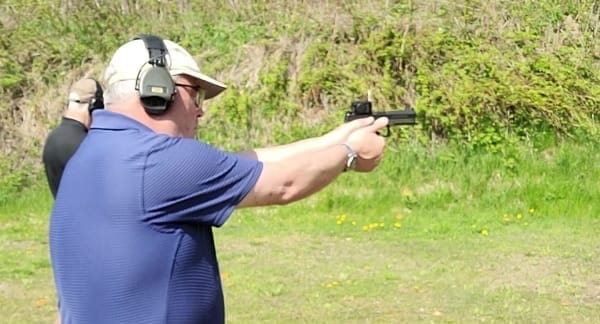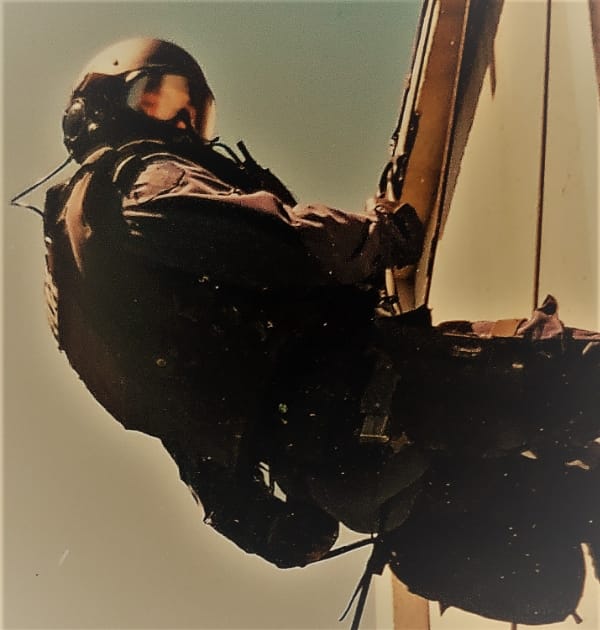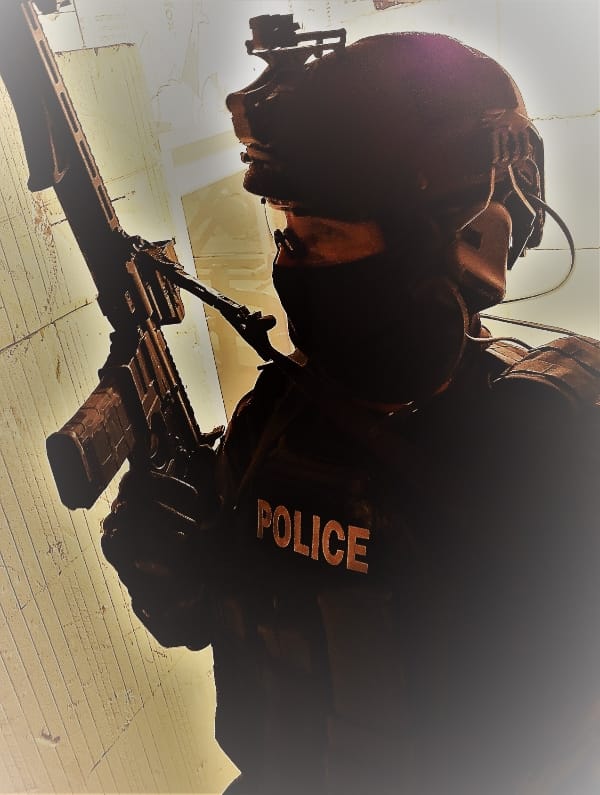Public Sector Services
Public Sector Services
Law Enforcement, Military, & Security Development Services:


HRT+D is committed to providing the fundamentals for successful skills development with safety as the cornerstone of the process.
Skills perishability is always a challenge which requires continuous maintenance on behalf of all clients. HRT+D believes that whether you are a general duty/patrol officer, an ERT assaulter, or a sport shooter, all clients should develop the same fundamentals. For that reason, you will never see an “advanced fundamental course” listed on this website, everyone is provided the same techniques required to be a safe, competent, and accurate firearms operator.
All clients need to do is identify the skill development area of interest from the menu of options. It will be incumbent upon all clients to engage in continuous skill development to reach their desired proficiency level.
Please Note:
-
- Private lessons are available if requested. The costs associated with this training is more than group lessons. Please contact HRT+D directly for a quote.
-
To register for the “Day 2” courses, you must be able to prove you belong to an accredited law enforcement, military, or government protective / security services agency.
-
Typically, the firearm courses are provided during the spring, summer and fall months.
-
Prior to engaging in any skills development associated to the listed firearms training, all seasons start with a safety and medical briefing. All those interested in taking one of the listed firearms training sessions will be required to send specific information as outlined in the course requirements section to HRTandD@gmail.com.
-
HRT+D can offer operator trainer courses if required for all applicable platforms.

Tactical Pistol Operator Fundamentals:
Day 1
Duration: Average 10 hours
Description: This course will provide the foundational blocks required to be proficient with your pistol.
The course can provide skill development in the areas of equipment setup, review of the fundamentals of shooting and malfunctions, drawing, presentation and set time, loading / unloading, multiple shots/multiple threats, one handed shooting and shooting on the move.
Other skills could include cadence/rhythm drills, diagnosing issues and shooting from distance depending on time availability.
The above listed menu of skills can be modified based on client requirements.
Requirements:
- Agency credentials – badge/ID and RPAL.
- A reliable zeroed semi-auto pistol with iron sights and/or optic and three magazines.
- Duty belt (inner/outer belts) with appropriate keepers, holster, and magazine pouches.
- Firearm chamber safety flag/plug.
- Body Armour, soft and/or hard (for those belonging to public safety agency).
- Certified eye and hearing protection
- Hat with brim (i.e., baseball hat) and appropriate clothing for weather conditions.
- Water and snacks.
- Approximately 250 rounds of reliable ammunition. Consider bring more ammunition as other skills may be taught depending on time availability.
- Optional items: Sunscreen, insect repellent, gloves and face mask.
Scheduling: Once the course has eight persons registered, the date for the training will be set and payment will be requested via email. Courses maybe during weekdays and/or weekends, depending on range availability.

Tactical Pistol Operator Fundamentals:
Day 2
Duration: Average 10 hours
Description:
This course can provide skill development in the following areas depending on client requirements; compressed environment/pistol retention (compressed front, dominant and non-dominant side encounters)/getting off the X, off cover (changing position), disruptive environment/stress inoculation shooting, engaging moving targets, modified shooting positions, injured officer/pistol manipulation (reloading), one dimensional Close Quarter Battle (CQB) squaring the threshold and simulated one dimensional life fire vehicle CQB.
The client group will need to identify their top four skill development priorities from the above skills menu as time may not permit the covering of all the listed training.
Requirements:
- Agency credentials – badge/ID.
- A reliable zeroed semi-auto pistol with iron sights and or optic and three magazines.
- Duty belt (inner/outer belts) with appropriate keepers, holster, and magazine pouches.
- Firearm chamber safety flag/plug.
- Body armour, soft and/or hard.
- Certified eye and hearing protection.
- Hat with brim (i.e., baseball hat) and appropriate clothing for weather conditions.
- Water and snacks.
- Approximately 250 rounds of reliable ammunition. Consider bring more ammunition as other skills may be taught depending on time availability.
- Optional items: Sunscreen, insect repellent, gloves and face mask.
Scheduling: Once the course has eight persons registered, the date for the training will be set and payment will be requested via email. Courses may be during weekdays and/or weekends, depending on range availability.

Tactical Carbine Operator Fundamentals:
Day 1
Duration: Average 10 hours
Description:
This course will provide individuals the training required to safely operate this type of platform, from hunter to sport shooter to law enforcement officer. The course can provide skill development in the areas of equipment setup, review of the fundamentals of shooting, barrel sight relationship, presentation and set time, clearing malfunctions, loading/unloading, open field, multiple shots/multiple targets and rhythm/cadence drills. Depending on available time, transitions, off cover, static and walking turns, shooting on the move, and shooting from distance may be included.
The above listed menu of skills can be modified based on client requirements.
Requirements:
- Agency credentials – badge/ID and PAL.
- A zeroed semi-auto carbine rifle (pistol calibre is acceptable) with iron sights and or optic, single- or two-point sling, and 3 magazines.
- A reliable zeroed semi-auto pistol with iron sights and or optic and three magazines.
- Duty belt (inner/outer belts) with appropriate keepers, holster, and magazine pouches.
- Firearm chamber safety flag/plug
- Body armour, soft and or hard with molle and associated rifle magazine pouches or magazine pouches on duty belt.
- Certified eye and hearing protection.
- Hat with brim (i.e. baseball hat) and appropriate clothing for weather conditions.
- Water and snacks.
- Approximately 250 rounds of reliable ammunition. Consider bring more ammunition as other skills may be taught depending on time availability.
- Optional items: Sunscreen, insect repellent, gloves and face mask.
Scheduling: Once the course has eight persons registered the date for the training will be set and payment will be requested via email. Courses maybe during weekdays and or weekends depending on range availability.

Tactical Carbine Operator Fundamentals:
Day 2
Duration: Average 10 hours
Description:
This course can provide skill development in the following areas compressed environment/retention (compressed front – “short sticking”, dominant and non-dominant side encounters), off cover (changing position), disruptive environment/stress inoculation shooting, engaging moving targets, and modified shooting positions, injured officer/carbine manipulation (reloading), one dimensional live fire CQB squaring the threshold and one-dimensional live fire vehicle simulated CQB.
The client group will need to identify their top four skill development priorities from the above skills menu as time may not permit the covering of all the listed training.
Requirements:
- Agency credentials – badge/ID.
- A zeroed semi-auto carbine rifle (pistol calibre is acceptable) with iron sights and or optic, single- or two-point sling, and 3 magazines.
- A reliable zeroed semi-auto pistol with iron sights and or optic and three magazines.
- Duty belt (inner/outer belts) with appropriate keepers, holster, and magazine pouches.
- Firearm chamber safety flag/plug.
- Body armour, soft and/or hard.
- Certified eye and hearing protection.
- Hat with brim (i.e., baseball hat) and appropriate clothing for weather conditions.
- Water and snacks.
- Approximately 250 rounds of reliable ammunition. Consider bring more ammunition as other skills may be taught depending on time availability.
- Optional items: Sunscreen, insect repellent, gloves and face mask.
Scheduling: Once the course has eight persons registered, the date for the training will be set and payment will be requested via email. Courses may be during weekdays and/or weekends, depending on range availability.

Tactical Pump Action Shotgun Operator:
Day 1
Duration: Average 10 hours
Description:
This course can assist those officers without a general duty patrol carbine program by providing them a long gun training option, as well as those who use a shotgun for hunting. This course can provide skill development in the areas of equipment setup, review of the fundamentals of shooting, barrel sight relationship, presentation and set time, clearing malfunctions, loading/unloading, open field, multiple shots/multiple targets and rhythm/cadence drills. Depending on available time, transitions, off cover, static and walking turns, shooting on the move and shooting from distance may be included in the day’s skill development.
The above listed menu of skills can be modified based on client requirements.
Requirements:
- Agency credentials – badge/ID.
- A zeroed reliable pump action shotgun with iron sights and/or optic and single- or two-point sling.
- Duty belt (inner/outer belts) with appropriate keepers, holster and magazine pouches.
- Side Saddle, buttstock shell sleeve, bandolier carrier on molle or on duty belt, or a combination thereof.
- Firearm chamber safety flag/plug.
- Body armour, soft and/or hard.
- Certified eye and hearing protection.
- Hat with brim (i.e., baseball hat) and appropriate clothing for weather conditions.
- Water and snacks.
- 200 Rounds of Bird Shot – 7, 7.5 to 8 Shot
- 50 Rounds of Rifle Slug
- 50 Rounds of 00 Buck
- Optional items: Sunscreen, insect repellent, gloves and face mask.
Scheduling: Once the course has eight persons registered, the date for the training will be set and payment will be requested via email. Courses may be during weekdays and/or weekends, depending on range availability.

Tactical Pump Action Shotgun Operator:
Day 2
Duration: Average 10 hours
Description:
This course can provide skill development in the following areas compressed environment/retention (compressed front – “short sticking”, dominant and non-dominant side encounters), off cover (changing position), disruptive environment/stress inoculation shooting, engaging moving targets, and modified shooting positions, injured officer/carbine manipulation (reloading), one dimensional CQB squaring the threshold and one-dimensional live fire vehicle simulated CQB.
The client group will need to identify their top four skill development priorities from the above skills menu as time may not permit the covering of all the listed training.
Requirements:
- Agency credentials – badge/ID.
- A zeroed reliable pump action shotgun with iron sights and/or optic and single- or two-point sling.
- Side Saddle, buttstock shell sleeve, bandolier carrier on molle or on duty belt, or a combination thereof.
- Duty belt (inner/outer belts) with appropriate keepers, holster, and magazine pouches.
- Firearm chamber safety flag/plug.
- Body armour, soft and/or hard.
- Certified eye and hearing protection.
- Hat with brim (i.e., baseball hat) and appropriate clothing for weather conditions.
- Water and snacks.
- 200 Rounds of Bird Shot – 7, 7.5 to 8 Shot
- 50 Rounds of Rifle Slug
- 50 Rounds of 00 Buck
- Optional items: Sunscreen, insect repellent, gloves and face mask.
Scheduling: Once the course has eight persons registered, the date for the training will be set and payment will be requested via email. Courses may be during weekdays and/or weekends, depending on range availability.

Conversion From Iron Sights To Red Dot
Duration: Average 10 hours
Description:
Public Safety services and sport shooters have recognized the importance of improving their skills through the adoption of new tools.
Converting from iron sights to a red dot presents unique learning challenges. HRT+D is able to offer best practices as it relates to these transition challenges.
This course will cover advantages/disadvantages of red dot, fundamentals of shooting as it pertains to red dots, trouble-shooting the acquisition of red dot, catastrophic failure, multiple shots/multiple threats, and shooting on the move. Other skills could include zeroing/shooting from distance depending on time availability.
Requirements:
- RPAL.
- A reliable zeroed semi-auto pistol with iron sights and/or optic and three magazines.
- Reliable belt (inner/outer belts) with appropriate keepers, holster, and magazine pouches.
- Firearm chamber safety flag/plug.
- Certified eye and hearing protection
- Hat with brim (i.e., baseball hat) and appropriate clothing for weather conditions.
- Water and snacks.
- Approximately 250 rounds of reliable ammunition. Consider bring more ammunition as other skills may be taught depending on time availability.
- Optional items: Sunscreen, insect repellent, gloves and face mask.
Scheduling: Once the course has eight persons registered, the date for the training will be set and payment will be requested via email. Courses may be during weekdays and/or weekends, depending on range availability.

Possession & Acquisition License (PAL) and Restricted Possession & Acquisition License (RPAL) Courses
Duration: 8 hours of in-class instruction, followed by a written and practical test.
Description:
If you want to use non-restricted firearms (many rifles and shotguns) in Canada, you must obtain a Firearms Possession and Acquisition licence (PAL). In order to apply for a PAL, first-time applicants must pass the Canadian Firearms Safety Course (CFSC). The course consists of 8 hours of in-class instruction, followed by a written and practical test.
Some agencies which use restricted firearms may require applicants and/or employees to obtain a Restricted Possession and Acquisition Licence (RPAL). To obtain this licence, you must complete the Canadian Restricted Firearms Safety Course (CRFSC) and pass the written and practical tests. You must successfully complete the CFSC prior to taking the CRFSC. The 2 courses can be offered as a back-to-back package, usually given over 2–3 days.
Topics Covered Include:
-
Evolution of firearms, major parts, types and actions;
-
Basic firearms safety practices;
-
Ammunition;
-
Operating firearm actions;
-
Safe handling and carry procedures;
-
Firing techniques and procedures;
-
Care of non-restricted and restricted firearms;
-
Responsibilities of the firearms owner/user; and
-
Safe storage, display, transportation and handling of non-restricted and/or restricted firearms.
Hawthorne’s team can deliver the CFSC and CRFSC to your group of 5–10 at times and locations that work best for your team within the Ottawa region. For individuals wishing to take either course, courses are scheduled based on demand and instructor availability in the Ottawa area.
Prices are set by the Firearms Safety Education Service of Ontario, who are responsible for the training of instructors in Ontario. Contact us for pricing and delivery options.

Tactical Pistol Operator Fundamentals:
Day 1
Duration: Average 10 hours
Description: This course will provide the foundational blocks required to be proficient with your pistol.
The course can provide skill development in the areas of equipment setup, review of the fundamentals of shooting and malfunctions, drawing, presentation and set time, loading / unloading, multiple shots/multiple threats, one handed shooting and shooting on the move.
Other skills could include cadence/rhythm drills, diagnosing issues and shooting from distance depending on time availability.
The above listed menu of skills can be modified based on client requirements.
Requirements:
- Agency credentials – badge/ID and RPAL.
- A reliable zeroed semi-auto pistol with iron sights and/or optic and three magazines.
- Duty belt (inner/outer belts) with appropriate keepers, holster, and magazine pouches.
- Firearm chamber safety flag/plug.
- Body Armour, soft and/or hard (for those belonging to public safety agency).
- Certified eye and hearing protection
- Hat with brim (i.e., baseball hat) and appropriate clothing for weather conditions.
- Water and snacks.
- Approximately 250 rounds of reliable ammunition. Consider bring more ammunition as other skills may be taught depending on time availability.
- Optional items: Sunscreen, insect repellent, gloves and face mask.
Scheduling: Once the course has eight persons registered, the date for the training will be set and payment will be requested via email. Courses maybe during weekdays and/or weekends, depending on range availability.

Tactical Pistol Operator Fundamentals:
Day 2
Duration: Average 10 hours
Description:
This course can provide skill development in the following areas depending on client requirements; compressed environment/pistol retention (compressed front, dominant and non-dominant side encounters)/getting off the X, off cover (changing position), disruptive environment/stress inoculation shooting, engaging moving targets, modified shooting positions, injured officer/pistol manipulation (reloading), one dimensional Close Quarter Battle (CQB) squaring the threshold and simulated one dimensional life fire vehicle CQB.
The client group will need to identify their top four skill development priorities from the above skills menu as time may not permit the covering of all the listed training.
Requirements:
- Agency credentials – badge/ID.
- A reliable zeroed semi-auto pistol with iron sights and or optic and three magazines.
- Duty belt (inner/outer belts) with appropriate keepers, holster, and magazine pouches.
- Firearm chamber safety flag/plug.
- Body armour, soft and/or hard.
- Certified eye and hearing protection.
- Hat with brim (i.e., baseball hat) and appropriate clothing for weather conditions.
- Water and snacks.
- Approximately 250 rounds of reliable ammunition. Consider bring more ammunition as other skills may be taught depending on time availability.
- Optional items: Sunscreen, insect repellent, gloves and face mask.
Scheduling: Once the course has eight persons registered, the date for the training will be set and payment will be requested via email. Courses may be during weekdays and/or weekends, depending on range availability.

Tactical Carbine Operator Fundamentals:
Day 1
Duration: Average 10 hours
Description:
This course will provide individuals the training required to safely operate this type of platform, from hunter to sport shooter to law enforcement officer. The course can provide skill development in the areas of equipment setup, review of the fundamentals of shooting, barrel sight relationship, presentation and set time, clearing malfunctions, loading/unloading, open field, multiple shots/multiple targets and rhythm/cadence drills. Depending on available time, transitions, off cover, static and walking turns, shooting on the move, and shooting from distance may be included.
The above listed menu of skills can be modified based on client requirements.
Requirements:
- Agency credentials – badge/ID and PAL.
- A zeroed semi-auto carbine rifle (pistol calibre is acceptable) with iron sights and or optic, single- or two-point sling, and 3 magazines.
- A reliable zeroed semi-auto pistol with iron sights and or optic and three magazines.
- Duty belt (inner/outer belts) with appropriate keepers, holster, and magazine pouches.
- Firearm chamber safety flag/plug
- Body armour, soft and or hard with molle and associated rifle magazine pouches or magazine pouches on duty belt.
- Certified eye and hearing protection.
- Hat with brim (i.e. baseball hat) and appropriate clothing for weather conditions.
- Water and snacks.
- Approximately 250 rounds of reliable ammunition. Consider bring more ammunition as other skills may be taught depending on time availability.
- Optional items: Sunscreen, insect repellent, gloves and face mask.
Scheduling: Once the course has eight persons registered the date for the training will be set and payment will be requested via email. Courses maybe during weekdays and or weekends depending on range availability.

Tactical Carbine Operator Fundamentals:
Day 2
Duration: Average 10 hours
Description:
This course can provide skill development in the following areas compressed environment/retention (compressed front – “short sticking”, dominant and non-dominant side encounters), off cover (changing position), disruptive environment/stress inoculation shooting, engaging moving targets, and modified shooting positions, injured officer/carbine manipulation (reloading), one dimensional live fire CQB squaring the threshold and one-dimensional live fire vehicle simulated CQB.
The client group will need to identify their top four skill development priorities from the above skills menu as time may not permit the covering of all the listed training.
Requirements:
- Agency credentials – badge/ID.
- A zeroed semi-auto carbine rifle (pistol calibre is acceptable) with iron sights and or optic, single- or two-point sling, and 3 magazines.
- A reliable zeroed semi-auto pistol with iron sights and or optic and three magazines.
- Duty belt (inner/outer belts) with appropriate keepers, holster, and magazine pouches.
- Firearm chamber safety flag/plug.
- Body armour, soft and/or hard.
- Certified eye and hearing protection.
- Hat with brim (i.e., baseball hat) and appropriate clothing for weather conditions.
- Water and snacks.
- Approximately 250 rounds of reliable ammunition. Consider bring more ammunition as other skills may be taught depending on time availability.
- Optional items: Sunscreen, insect repellent, gloves and face mask.
Scheduling: Once the course has eight persons registered, the date for the training will be set and payment will be requested via email. Courses may be during weekdays and/or weekends, depending on range availability.

Tactical Pump Action Shotgun Operator:
Day 1
Duration: Average 10 hours
Description:
This course can assist those officers without a general duty patrol carbine program by providing them a long gun training option, as well as those who use a shotgun for hunting. This course can provide skill development in the areas of equipment setup, review of the fundamentals of shooting, barrel sight relationship, presentation and set time, clearing malfunctions, loading/unloading, open field, multiple shots/multiple targets and rhythm/cadence drills. Depending on available time, transitions, off cover, static and walking turns, shooting on the move and shooting from distance may be included in the day’s skill development.
The above listed menu of skills can be modified based on client requirements.
Requirements:
- Agency credentials – badge/ID.
- A zeroed reliable pump action shotgun with iron sights and/or optic and single- or two-point sling.
- Duty belt (inner/outer belts) with appropriate keepers, holster and magazine pouches.
- Side Saddle, buttstock shell sleeve, bandolier carrier on molle or on duty belt, or a combination thereof.
- Firearm chamber safety flag/plug.
- Body armour, soft and/or hard.
- Certified eye and hearing protection.
- Hat with brim (i.e., baseball hat) and appropriate clothing for weather conditions.
- Water and snacks.
- 200 Rounds of Bird Shot – 7, 7.5 to 8 Shot
- 50 Rounds of Rifle Slug
- 50 Rounds of 00 Buck
- Optional items: Sunscreen, insect repellent, gloves and face mask.
Scheduling: Once the course has eight persons registered, the date for the training will be set and payment will be requested via email. Courses may be during weekdays and/or weekends, depending on range availability.

Tactical Pump Action Shotgun Operator:
Day 2
Duration: Average 10 hours
Description:
This course can provide skill development in the following areas compressed environment/retention (compressed front – “short sticking”, dominant and non-dominant side encounters), off cover (changing position), disruptive environment/stress inoculation shooting, engaging moving targets, and modified shooting positions, injured officer/carbine manipulation (reloading), one dimensional CQB squaring the threshold and one-dimensional live fire vehicle simulated CQB.
The client group will need to identify their top four skill development priorities from the above skills menu as time may not permit the covering of all the listed training.
Requirements:
- Agency credentials – badge/ID.
- A zeroed reliable pump action shotgun with iron sights and/or optic and single- or two-point sling.
- Side Saddle, buttstock shell sleeve, bandolier carrier on molle or on duty belt, or a combination thereof.
- Duty belt (inner/outer belts) with appropriate keepers, holster, and magazine pouches.
- Firearm chamber safety flag/plug.
- Body armour, soft and/or hard.
- Certified eye and hearing protection.
- Hat with brim (i.e., baseball hat) and appropriate clothing for weather conditions.
- Water and snacks.
- 200 Rounds of Bird Shot – 7, 7.5 to 8 Shot
- 50 Rounds of Rifle Slug
- 50 Rounds of 00 Buck
- Optional items: Sunscreen, insect repellent, gloves and face mask.
Scheduling: Once the course has eight persons registered, the date for the training will be set and payment will be requested via email. Courses may be during weekdays and/or weekends, depending on range availability.

Conversion From Iron Sights To Red Dot
Duration: Average 10 hours
Description:
Public Safety services and sport shooters have recognized the importance of improving their skills through the adoption of new tools.
Converting from iron sights to a red dot presents unique learning challenges. HRT+D is able to offer best practices as it relates to these transition challenges.
This course will cover advantages/disadvantages of red dot, fundamentals of shooting as it pertains to red dots, trouble-shooting the acquisition of red dot, catastrophic failure, multiple shots/multiple threats, and shooting on the move. Other skills could include zeroing/shooting from distance depending on time availability.
Requirements:
- RPAL.
- A reliable zeroed semi-auto pistol with iron sights and/or optic and three magazines.
- Reliable belt (inner/outer belts) with appropriate keepers, holster, and magazine pouches.
- Firearm chamber safety flag/plug.
- Certified eye and hearing protection
- Hat with brim (i.e., baseball hat) and appropriate clothing for weather conditions.
- Water and snacks.
- Approximately 250 rounds of reliable ammunition. Consider bring more ammunition as other skills may be taught depending on time availability.
- Optional items: Sunscreen, insect repellent, gloves and face mask.
Scheduling: Once the course has eight persons registered, the date for the training will be set and payment will be requested via email. Courses may be during weekdays and/or weekends, depending on range availability.

Possession & Acquisition License (PAL) and Restricted Possession & Acquisition License (RPAL) Courses
Duration: 8 hours of in-class instruction, followed by a written and practical test.
Description:
If you want to use non-restricted firearms (many rifles and shotguns) in Canada, you must obtain a Firearms Possession and Acquisition licence (PAL). In order to apply for a PAL, first-time applicants must pass the Canadian Firearms Safety Course (CFSC). The course consists of 8 hours of in-class instruction, followed by a written and practical test.
Some agencies which use restricted firearms may require applicants and/or employees to obtain a Restricted Possession and Acquisition Licence (RPAL). To obtain this licence, you must complete the Canadian Restricted Firearms Safety Course (CRFSC) and pass the written and practical tests. You must successfully complete the CFSC prior to taking the CRFSC. The 2 courses can be offered as a back-to-back package, usually given over 2–3 days.
Topics Covered Include:
-
Evolution of firearms, major parts, types and actions;
-
Basic firearms safety practices;
-
Ammunition;
-
Operating firearm actions;
-
Safe handling and carry procedures;
-
Firing techniques and procedures;
-
Care of non-restricted and restricted firearms;
-
Responsibilities of the firearms owner/user; and
-
Safe storage, display, transportation and handling of non-restricted and/or restricted firearms.
Hawthorne’s team can deliver the CFSC and CRFSC to your group of 5–10 at times and locations that work best for your team within the Ottawa region. For individuals wishing to take either course, courses are scheduled based on demand and instructor availability in the Ottawa area.
Prices are set by the Firearms Safety Education Service of Ontario, who are responsible for the training of instructors in Ontario. Contact us for pricing and delivery options.
Use of Force Training
Depending on your needs, HRT+D can provide a comprehensive delivery of techniques and tactics related to your commonly deployed intermediate use of force tools (Baton, OC Spray, and Conducted Energy Weapon) as well as key concepts related to defensive tactics such as strikes and ground fighting.
Most important to understanding the application of force is the utilization of an appropriate decision-making process/model which is aligned with legislation and a department’s policies.
HRT+D can provide learning principles specific to time constrained risk assessments and use of force model training. As earlier identified in our list of development/review services a full suite of policy and procedures development is available in this area.
To facilitate your agency’s requirements in this area, please contact HRT+D directly to discuss your needs, duration of training and costs.


Specialty Services
Speciality training such as Active Threat Response (ATR) Fundamentals, Structure CQB Fundamentals, Vehicle CQB Fundamentals, etc. can be provided by HRT+D.
If you are interested in any of these specialized courses, individuals/agencies must contact HRT+D directly to discuss their requirements, and the associated venue and logistical capabilities needed to delivery this training, along with duration and costs.
This training can be tailored to an agency’s needs as only parts of the identified training may be required. As such, all specialized training can be delivered in various formats, from presentations to tabletop directed learning to simulated/dry fire to actual live fire venues and or a combination of some or all of these elements.
